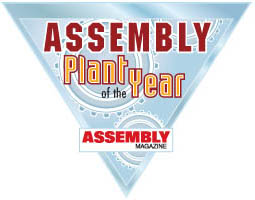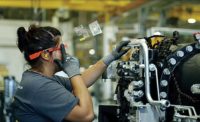
2008 Assembly Plant of the Year Award - Call for Entries
Lean Tools Play a Key Role at Award-Winning Plants
This year, ASSEMBLY magazine is celebrating the 5th anniversary of itsAssembly Plant of the Year award. The program was established in 2004 to showcase world-class production facilities located in the United States. The award has been presented to plants owned and operated by Kenworth Truck Co. (Kirkland, WA), Lear Corp. (Troy, MI), Schneider Electric/SquareD (Palatine, IL) and Xerox Corp. (Stamford, CT).One goal of the award is to highlight the diversity of manufacturing plants and processes that ASSEMBLY covers every month. Indeed, the first four recipients of theAssembly Plant of the Yearaward are each involved in unique industries: heavy-duty trucks, car seats, electrical distribution equipment and digital printing presses.
They are also located in different parts of the country: Alabama, Kentucky New York and Washington. Two of the plants are relatively new (Kenworth and Lear), while the other facilities are each more than 45 years old (Square D and Xerox). But, despite those differences, they each share something in common: A keen embrace of lean manufacturing principles and a plant-wide desire for continuous improvement.
For instance, at Kenworth’s Renton, WA, plant, kaizen events are common. They have eliminated non-value-added activities and generated significant savings by reducing inventory, scrap and dunnage, as well as relocating parts for easier access and reduced walking distances.
When its customer required a major increase in throughput, a kaizen team at Lear’s Montgomery, AL, plant incorporated a new layout that implemented cellular builds to better utilize floor space, while providing a better flow of materials. After identifying where people needed to be added on the assembly line, simulation models allowed the team to identify the best sequence of operation for the production tasks.
The team of managers and operators then validated the study by conducting actual time studies to ensure that the operations could be performed at takt time. Ultimately, the kaizen was a success, and Lear Montgomery met its customer’s goals, delivering increased productivity through better material flow.
By implementing lean work processes, Xerox’s Webster, NY, plant has also become faster and more flexible. For instance, the plant has adopted a smaller footprint. The size of the shop floor has shrunk from 790,000 square feet to less than 500,000 square feet by consolidating and transforming the facility from three distinct areas into one manufacturing area. The consolidation has simplified material flow and reduced operating costs.
A recent lean initiative at the Square D/Schneider Electric plant in Lexington, KY, involves visual management systems. The plant uses group-level short interval management (SIM) boards to improve productivity. For example, safety performance visuals feature safety crosses that show the number of days worked with no recordable safety accidents. Other visuals depict cross-rotational training assignments, root-cause analysis on repetitive production barriers, and by-hour production barrier logs.
Prior to implementing SIM, many small, repetitive issues were not captured. By focusing on a much smaller time increment, one hour at a time, the plant began documenting production barriers that prevent assemblers from achieving takt time. After issues are captured, they are discussed in each value stream team at the start of a shift, then prioritized and worked to corrective action.
Click here to learn more about the 2008Assembly Plant of the Yearaward and find anomination form.

